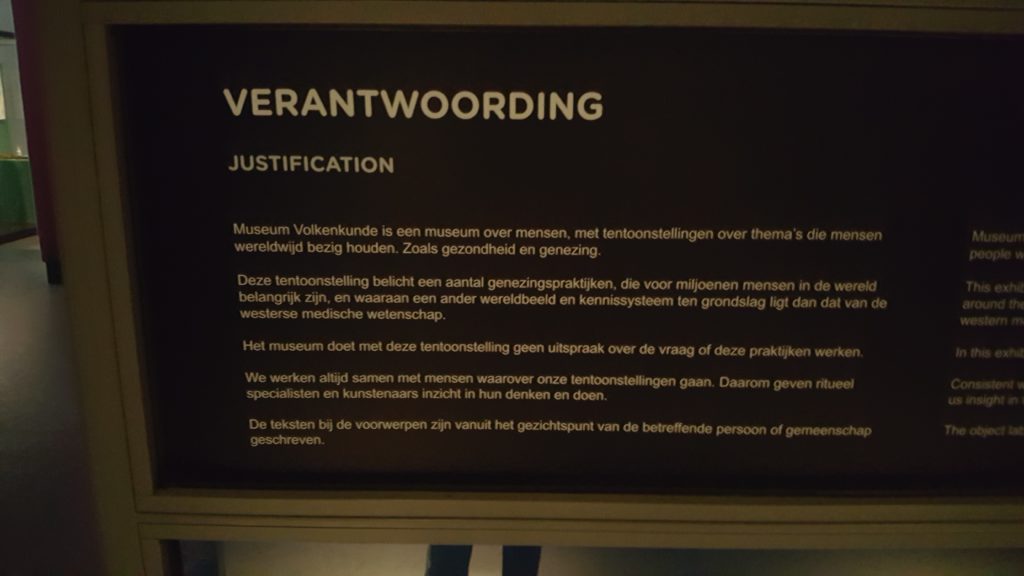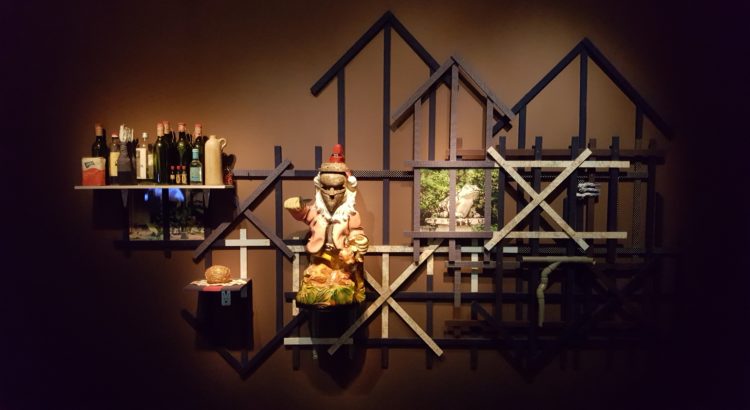‘Mysterious’, ‘exotic’ and ‘supernatural’ would be the first words that I would think about when confronted with the subject of alternative healing methods. This vision on alternative healing is nowadays mostly developed through watching movies or television series in which shamanism or voodoo are used to explain the unexplainable. In many occasions these films and series use a historic theme to justify the use of subjects related to alternative healing as it is an authentic representation of the era. It is no wonder then that terms like the ones I mentioned before play such a prevalent role when we get in touch with alternative healing methods in the western world. According to the few perspectives we are confronted with it is something of the past that has been replaced by something that was proven to work; western medicine and medical care.
Museum Volkenkunde in Leiden recognizes this one-sided vision on alternative healing in the western world and aims to: ‘Inspire an open mind on the world and to contribute to world citizenship’ with their new exhibition ‘Helende krachten’. The exhibition is based on the recognition that a steady resurgence of alternative healing methods in the western world is taking place, while in other parts of the world these methods are part of the local culture. With the collaboration of healers and artists that use alternative healing methods in the 21st century the museum tries to give the visitor an insight in the world outside of western medicine and movie theaters.
Making an exhibition based on a subject which is so distant to most of the western world is a bit of a gamble, especially when the subject matter has been viewed as quackery because of the lack of scientific evidence to support the results that alternative healing methods might have on our health. This last point has been the most prominent source of criticism from the public, leading to publications like the one of B. Scholtens, who points out the lack of a scientific medical perspective in the exhibition. According the museum the only thing the exhibition does is giving modern day healers and artists a stage to present their methods and expressions, without discussing the question if it works or not. I would argue that it is natural for anyone to want a complete picture of a particular subject when visiting a museum, it would be the perfect scenario. However it is simply not possible for a museum to manage that, especially in a temporarily exhibition with limited space. In that case it would be the choice of the museum to focus the subject matter and justify this choice. The latter is something museum Volkenkunde succeeds in.

It is however the focus on the subject matter in which the problem of the exhibition lies. When someone enters the 3-room exhibition it would be safe to assume they came to learn more about the world of alternative healing methods and to broaden their understanding of cultural traditions in other parts of the world. The exhibition disappoints in this aspect, and I found myself struggling to remind myself what I learned after my visit.
This can mostly be attributed to the two-faced nature of the exhibition. First the visitor is introduced to a room with stories from different practitioners of alternative healing methods, side by side with objects related to their craft. The movies of the different healers are the main attraction, while the objects and texts are merely supplementary to their story. In the second and third room the objects on display mostly consist of art pieces. Some of these have objects and artifacts as part of the artwork, while others are only related to the subject material.
The difference in style within the exhibition leads to a discontinuation of the story that is told. The visitor learns in the first room about the people that practice alternative healing nowadays, why they do it and where the tradition comes from. Although it is interesting to learn about the people behind it, there is a real lack of answers on other questions within this subject. How do they perform healing rituals? On what stories or beliefs are the methods based? Are there differences within the healing disciplines? I would argue that the answers to these questions are required for a deeper understanding of a subject as hard to grasp as alternative healing.
The rooms with art don’t add much to the knowledge of the visitor. If anything they give the feeling that the visitor is expected to have basic knowledge about the subject. But why would that be the case when alternative healing is such a rarely talked about subject in the western world? When I left the exhibition I felt like I had seen two different exhibitions, one about alternative healers in the 21st century and one about art based on alternative healing. In the end little was changed in my perspective on alternative healing, it is still mostly mysterious, exotic and supernatural.
Mats Jacobs
